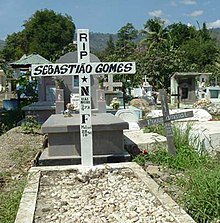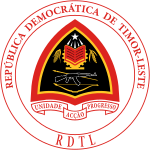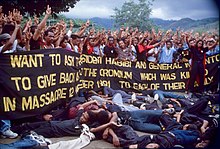
Carlos Filipe Ximenes Belo, SDB, commonly known as Carlos Belo or Ximenes Belo is an East Timorese prelate of the Catholic Church. He became a bishop in 1988 and served as the apostolic administrator of the Diocese of Díli from 1988 to 2002. In 1996, he shared the Nobel Peace Prize with José Ramos-Horta for working "towards a just and peaceful solution to the conflict in East Timor". He is a professed member of the Salesians.

East Timor, officially the Democratic Republic of Timor-Leste, is a country in Southeast Asia and Oceania. The country comprises the eastern half of the island of Timor and the nearby islands of Atauro and Jaco. The first inhabitants are thought to be descendant of Australoid and Melanesian peoples. The Portuguese began to trade with Timor by the early 16th century and colonised it throughout the mid-century. Skirmishing with the Dutch in the region eventually resulted in an 1859 treaty for which Portugal ceded the western half of the island. Imperial Japan occupied East Timor during World War II, but Portugal resumed colonial authority after the Japanese surrender.

Allan Nairn is an American investigative journalist. He was imprisoned by Indonesian military forces under United States-backed strongman Suharto while reporting in East Timor. His writings have focused on U.S. foreign policy in such countries as Haiti, Guatemala, Indonesia, and East Timor.

Max Christopher Wenner, known as Christopher Wenner and later as Max Stahl, was a British journalist and television presenter. He was best known for filming an East Timorese demonstration and its aftermath that became known as the Santa Cruz massacre. His coverage of East Timor's struggle for independence is listed in Unesco's Memory of the World register as a "turning point" in the birth of a new nation.

St Joseph's High School is a private Catholic secondary school, located in Dili, Timor Leste. The school was founded by the Catholic Diocese of Díli in 1983–84, when East Timor was still part of Indonesia. In 1993 the school was entrusted to the Society of Jesus, with a ten-year commitment.
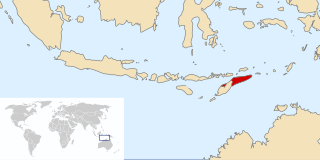
East Timor was a de facto province of Indonesia that existed between 1976 and 1999 during the Indonesian occupation of East Timor. Its territory corresponded to the previous Portuguese Timor and to the present-day independent country of Timor-Leste.

The Indonesian invasion of East Timor, known in Indonesia as Operation Lotus, began on 7 December 1975 when the Indonesian military (ABRI/TNI) invaded East Timor under the pretext of anti-colonialism and anti-communism to overthrow the Fretilin regime that had emerged in 1974. The overthrow of the popular and short-lived Fretilin-led government sparked a violent quarter-century occupation in which approximately 100,000–180,000 soldiers and civilians are estimated to have been killed or starved to death. The Commission for Reception, Truth and Reconciliation in East Timor documented a minimum estimate of 102,000 conflict-related deaths in East Timor throughout the entire period from 1974 to 1999, including 18,600 violent killings and 84,200 deaths from disease and starvation; Indonesian forces and their auxiliaries combined were responsible for 70% of the killings.

The Indonesian occupation of East Timor began in December 1975 and lasted until October 1999. After centuries of Portuguese colonial rule in East Timor, the 1974 Carnation Revolution in Portugal led to the decolonisation of its former colonies, creating instability in East Timor and leaving its future uncertain. After a small-scale civil war, the pro-independence Fretilin declared victory in the capital city of Dili and declared an independent East Timor on 28 November 1975.
The East Timor and Indonesia Action Network (ETAN) is a nonprofit US organization supporting human rights throughout Southeast Asia and Oceania. ETAN was founded in 1991 to support the right to self-determination of Timor-Leste. In 1999, that goal was significantly realized when the people of East Timor voted for independence. Since then ETAN has focused on building on its success in support of justice and self-determination in Timor-Leste and the surrounding region.

East Timor and Indonesia established diplomatic relations in 2002. Both share the island of Timor. Indonesia invaded the former Portuguese colony in 1975 and annexed East Timor in 1976, maintaining East Timor as its 27th province until a United Nations-sponsored referendum in 1999, in which the people of East Timor chose independence. Following a United Nations interim administration, East Timor gained independence in 2002. Indonesia already had a consulate in Dili during the Portuguese colonial period, though Indonesia formalized their relations by establishing an embassy in Dili. Since October 2002, East Timor has an embassy in Jakarta and consulates in Denpasar and Kupang. Relations between the two countries are generally considered highly positive, despite various problems. Numerous agreements regulate cooperation in different areas. East Timorese are visa-free in Indonesia.

The Church of Santo António de Motael is the oldest Roman Catholic church in East Timor and is located in Dili, the country's capital city. It is dedicated to Anthony of Padua. While the first church at this location was built around 1800, the current building dates back to 1955.

Guido Valadares was a Timorese politician and independence activist. He was a member of FRETILIN National Committee and the Vice-Minister of Labor and Social Welfare of the FRETILIN government in 1975". In 2003, the national hospital of East Timor was renamed in his honor, Guido Valadares National Hospital.
Rosa Muki Bonaparte was a Timorese politician and independence and women's rights activist. She was a member of FRETILIN National Committee in the mid 1970s. On 28 November 1975 she gave birth to the East Timor Popular Women's Organization when she "unfurled the new red, black and yellow flag with a white star." Her presidency was short-lived as just days later on 7 December 1975, Bonaparte was captured and executed by an Indonesian firing squad.

Chinese people in East Timor consist of Chinese migrants to East Timor and their descendants. The Chinese minority is a small proportion of the East Timorese population and most are Hakka and a small number of Cantonese within the populace. Many Chinese left during the mid-1970s.
Australia, a close neighbour of both Indonesia and East Timor, was the only country to recognise Indonesia's annexation of East Timor. Some members of the Australian public supported self-determination for East Timor, and also actively supported the independence movement within Australia. The Australian Government saw the need for both stability and good relations with their neighbour, Indonesia. However, it was criticised in some quarters, including by Xanana Gusmão for putting those issues above human rights. In 1998, the Howard government changed its stance and supported East Timor self-determination, prompting a referendum that saw East Timor gain its independence.

The East Timor genocide refers to the "pacification campaigns" of state terrorism which were waged by the Indonesian New Order government during the Indonesian invasion and occupation of East Timor. The majority of sources consider the Indonesian killings in East Timor to constitute genocide, while other scholars disagree on certain aspects of the definition.

Bella Galhos is a former East Timorese independence activist during the period of Indonesian occupation of East Timor and has been a translator, presidential advisor, human rights activist and environmentalist since independence in 2002.
Anarchism in East Timor has its roots in the country's history as a penal colony, when many anarchists were deported there. The movement eventually evolved into an anti-colonial struggle against succeeding occupying powers: first the Portuguese Empire, then the Japanese Empire and the Indonesian New Order, before the country finally achieved independence in 2002.
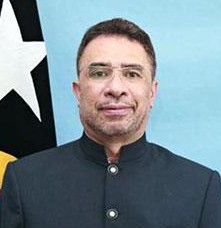
Hernâni Filomena Maria Coelho da Silva, also known by his nom de guerreNatan, is an East Timorese politician and diplomat, and a member of the Fretilin political party. He has been the East Timorese Ambassador to both Australia and South Korea. Between February 2015 and September 2017, he was Minister of Foreign Affairs and Cooperation, and from October 2017 to June 2018 he was Minister of Petroleum.

The 1975 Council of Ministers was the Council of Ministers formed by the Fretilin political party in 1975 as the inaugural administration or cabinet of the Democratic Republic of East Timor proclaimed in November 1975.
